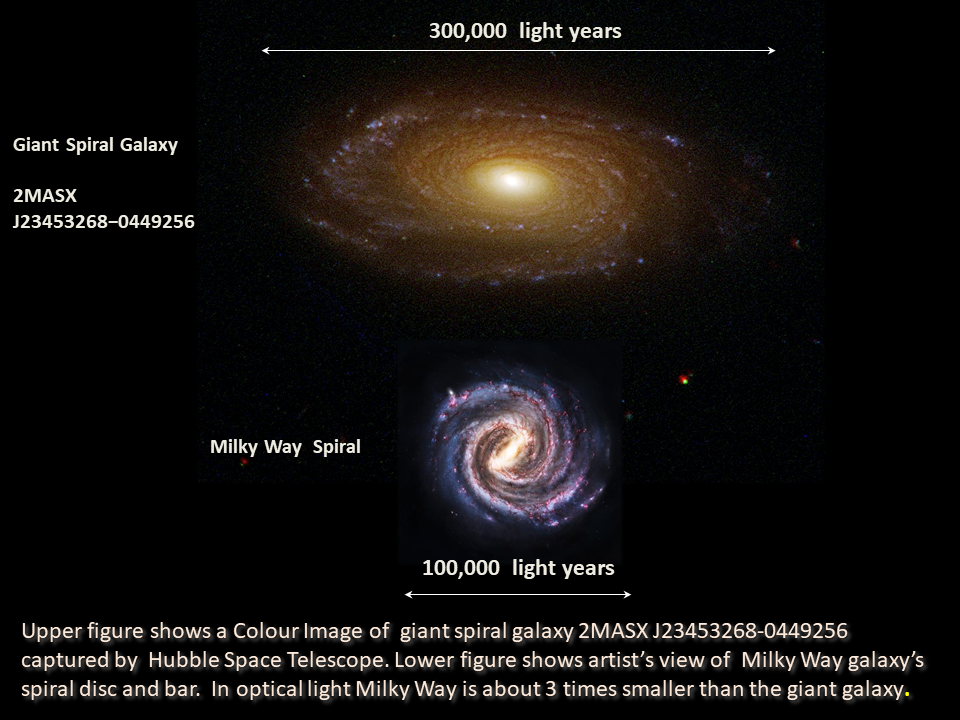Astronomers studying a massive and unusual spiral galaxy have found hints at the possible fate of our own home, the Milky Way.
ADVERTISEMENT
When looking at the universe, we have found plenty of evidence to support the current Concordance Lambda Cold Dark Matter (ΛCDM) model of it. But every now and then, astronomers have found some really weird objects that appear to challenge our ideas about how the cosmos works. Spiral galaxy 2MASX J23453268−0449256, 947 million light-years away from us in the constellation of Aquarius, is one such object.
The galaxy has a number of interesting properties, before we even get into the really weird stuff. The galaxy is rotating rapidly, may be one of the most massive galaxies in our local universe, and seems to be devoid of star-forming regions, with over 93 percent of the stellar mass in the galaxy forming more than around 10 billion years ago.
But what sparked the interest of the new team is that it is one of the largest radio sources ever found, with gigantic radio jets stretching 6 million light-years across emanating from the galactic nucleus. That is unexpected, given that these jets are almost always found in elliptical galaxies.
“These bright and enormous radio jets and lobes mark J2345−0449 as a unique source even among very massive spirals and the rapidly growing examples of [giant radio galaxies] in the local Universe, which themselves pose many important astrophysical questions,” the team explains in their study.
“Undoubtedly, this is a very unusual occurrence, since for reasons still unknown, such large-scale, powerful radio jets (typically on 100–1,000 kpc scale) are almost exclusively launched from bulge-dominated elliptical galaxies hosting [supermassive black holes], whereas the host of J2345−0449 is a spiral galaxy. Consequently, such counterintuitive [active galactic nuclei] challenge the standard paradigm of growth and co-evolution of massive [black holes] in bulges of galaxies and therefore, they are also of profound interest as they may be the ideal astrophysical models of the central engines of radio galaxies and their feedback signatures on the stellar and gaseous matter of the galaxy.”
Previously, it had been thought that these powerful jets could not exist in spiral galaxies, or more to the point, that spiral galaxies would not survive the violent jets. But 947 million light-years away, there sits J2345−0449, hosting well-defined spiral arms, an undisturbed stellar ring, a luminous nuclear bar, and an extremely active black hole sending powerful outflows of plasma and radio out into the cosmos.
ADVERTISEMENT
“This discovery is more than just an oddity – it forces us to rethink how galaxies evolve, and how supermassive black holes grow in them and shape their environments,” lead author Professor Joydeep Bagchi, of CHRIST University, Bangalore, said in a statement.
“If a spiral galaxy can not only survive but thrive under such extreme conditions, what does this mean for the future of galaxies like our own Milky Way? Could our galaxy one day experience similar high-energy phenomena that will have serious consequences for the survival of precious life in it?”
While finding a spiral galaxy that has survived such violent activity from the central supermassive black hole may sound like a “good thing”, it suggests that it’s possible that our own galaxy could undergo similar violence. For example, if a gas cloud, star, or small galaxy were to be accreted by our own black hole Sagittarius A*, it could potentially trigger jet activity. One pointed at our Solar System, depending on the strength, could strip away our planets’ atmospheres, damage the DNA of life due to radiation exposure, or damage our ozone layer and lead to mass extinction on Earth.

The giant spiral galaxy compared to our own.
The jets, according to the team, could also alter the interstellar medium and quash star formation.
ADVERTISEMENT
“Our detailed multiwavelength study of potential [star-forming] gas reveals that, while hot gas cools down in the massive extended halo of this galaxy, new stars do not form in the centre because of possible feedback from the central accreting [supermassive black hole] with its powerful radio jets, which heat up the gas again or push it beyond the galaxy’s reach,” the team writes in their conclusion. “For most of the galaxies like J2345−0449 and a few others observed, the activity of the [black hole] seems to have put an end to or drastically reduced star formation but has not yet succeeded in clearing them of all their cold gas.”
More detailed observations of the galaxy – which is also found to have around 10 times more dark matter than the Milky Way – is needed to make sense of this new, unexpected mystery, according to the team.
“Understanding these rare galaxies could provide vital clues about the unseen forces governing the universe – including the nature of dark matter, the long-term fate of galaxies, and the origin of life,” co-author Shankar Ray, a PhD student at CHRIST University, added.
“Ultimately, this study brings us one step closer to unravelling the mysteries of the cosmos, reminding us that the universe still holds surprises beyond our imagination.”
ADVERTISEMENT
The study is published in Monthly Notices of the Royal Astronomical Society.
Source Link: Clues To Our Galaxy's Fate Seen In One Of The Largest Radio Sources Ever Found